Taiwan - Hong Kong - Macau
(Photos WS)
The cruise of the "Ocean Princess", started on 21 March 2011 at Shanghai, is continuing to Hong Kong instead of Japan and as a compensation for not calling to far-away Vladivostok, Princess Cruises has added a call to Keelung, the seaport for Taipei, the capital of Taiwan, and so we have the occasion to see that prospering country, rarely visited by Europeans.
After having departed in the evening of 26 March from Incheon, the seaport for Korea's capital Seoul, the "Ocean Princess" is set for a south southwesterly course through the Yellow Sea. It's Sunday and an interdenominational church service is held by Captain Stefano Ravera in the Tahitian Lounge, the viewing lounge on deck 10. The victims of the recent earthquake in Japan and the fate of all the sailors are commemorated. It ends with the prayer:
O Holy Spirit, who didsd brood
Upon the waters dark and rude
And bid their angry tumult cease,
And give, for wild confusion, peace:
O hear us when we cry to Thee
For those in peril on the sea.
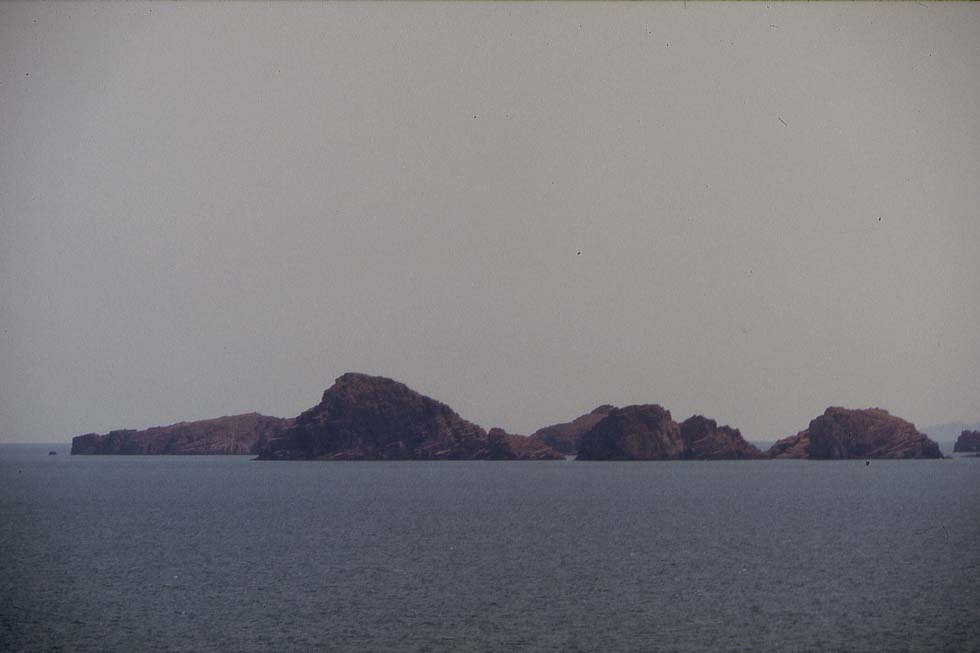
Hongdo Islands
Then a group of islands is appearing on port side, wild reddish rocks thrown into the blue sea, other islands in the background. A fishing-boat comes by, but fortunately we are not in the pirates' zone of Malacca. The group of islands is called Hongdo, what means Red Island. It is situated 115km southwest of the seaport Mokpo and belongs to Korea. So the 'land of the morning calm' is giving us a last farewell...
A formal dinner takes place in this evening and once again the Italian chef must be praised. Then a show is on the programme, "Ports of Call" with the acrobatic Ocean Princess Dancers, guiding us to the ports of Italy with 'O sole mio', to Europe and to Australia with 'Waltzing Mathilda' and of course to 'Brasil, Brasil' - it's fantastic.
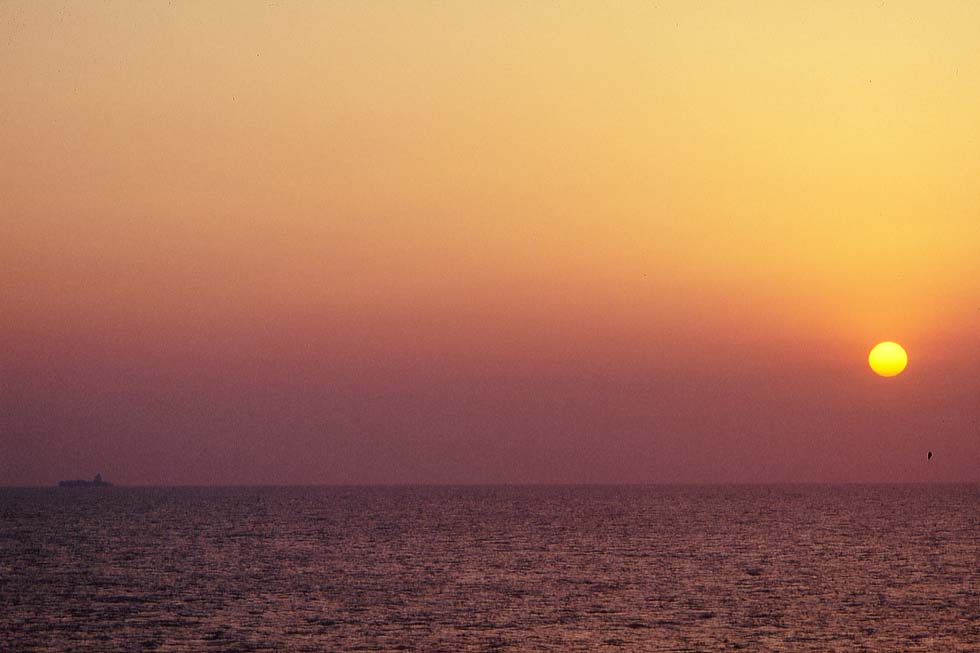
"Ocean Princess", Princess Cruises 2011
Monday is the first truly warm day, the first to enjoy the sun on the open deck. And the deck-chairs are not 'occupied' with towels like on some European ships. Our German tablemates are telling us the story of a cruise with a call to Civitavecchia, the seaport of Rome, and an audience with Pope Benedict. Some passenger asked him, how he could make his career so successfully and he answered, smiling: "I always woke up right in time and I always occupied the chairs with towels in due time." Far away another ship is accompanying us, southbound, too. And a glowing sun is setting into the light haze covering the calm sea.
Next day, Tuesday, 29 March, the "Ocean Princess" has her call at Keelung in Taiwan. The navigator informs via the board information sheet: "On our final approach we will enter the traffic separation scheme which will bring us to the entrance of the harbour. Once inside the harbour we will pass through Chi-Lung Kang proceeding to the inner harbour where we will come alongside to the passenger terminal." As the "Ocean Princess" of the so-called R-class is of a comparatively moderate size, she can moor there, while larger Princess Cruise ships have to berth at the container terminal.
Keelung is a picturesque town, built around the small bay, old and new quarters being spread below hills, covered with subtropical forests. On the opposite hill, the Guanyin Buddha Statue is enthroned. The station of the Cape gauge railway and an electric railcar of the Taiwan Railway Administration can be seen from the upper deck and an immense number of buses are parking nearby. One takes us on a modern motorway through the hilly valley to Taipei, not even 30km distant, past factories and living-quarters on a river shore and the almost abandoned old airport, into the capital. Skyscrapers are rising there, but they are nothing compared to the "One-O-One", the 101-storey tower, some years ago the highest in the world, overtopping everything. Though its architectural appearance may be liked or disliked, it is a masterpiece in engineering, constructed to be safe against earthquakes. And walking towards the traditional city center, the tourist is captured by the cleanness of the road, the discipline of the drivers, the Italian-style ladies' fashion and the obvious wealth, a 'Switzerland' in Far East. A look at the Chiang Kai-shek memorial is a "must", it's a white monumental building in a park filled with flowers, exaggerated, colossal, nevertheless of a good architecture. Parks and busy roads are surrounding official buildings and the nice modern railway station. Sadly, there is no time for visiting the Shandao or the Longshan Temple. The bus is awaiting us near the One-O-One Tower for boarding the "Ocean Princess" right in time for not getting lost in Taiwan, in a Far East paradise...
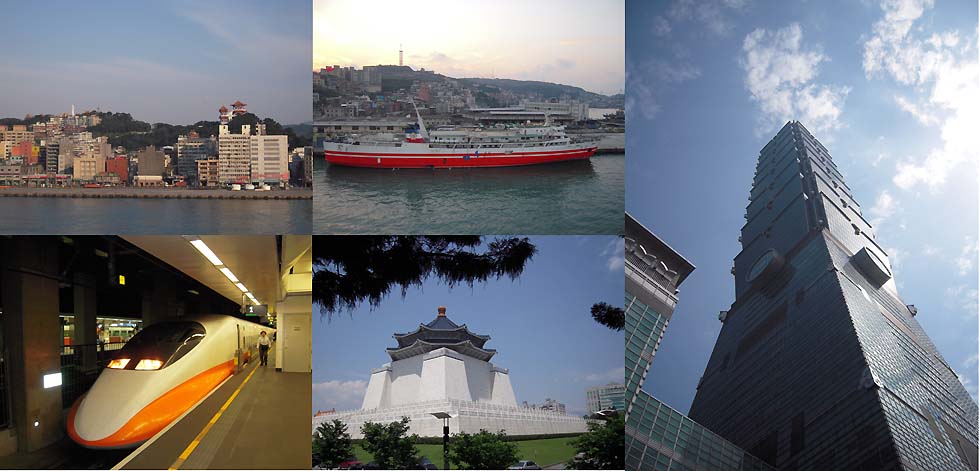
Keelung with the Guanyin Buddha Statue; Keelung terminal; Taipei, the One-O-One; High-speed 700T of TRTS, Taipeh 2011; Chiang Kai-shek Mausoleum
Back to the ship, Taiwanese drummers can be listened playing on the pier, then the signal of the "Ocean Princess" is drowning their rhythm and the ship moves out of the harbour, past two small island ferries, the container terminal and a pyramidal rock in the sea. Night has fallen. After the ship has passed the northern tip of Taiwan, the course is altered to a south westerly direction along the coast in the distance, and still for hours the lights of the densely populated region can be seen.
Wednesday, 30 March 2011, the last day on the open sea: The Pescadores and other islands must have been passed already during night hours. The sky is now covered with clouds, waves are splashing, some 10 to 15 feet high, it's the eastern monsoon. The "Ocean Princess" however is running quietly despite her size of only c.30,000 gross tons. The American friend Mark tells us stories of his cruises, the experience aboard a mega ship cruising off the Chilean coast near Cape Horn when it was rolling tremendously, or his voyage aboard an R-class ship upstream the Amazon, rendered possible thanks to her moderate size. In Manaus, of course the passengers had visited the Opera house, where long before Caruso had given his performance... "During the day we will follow a south westerly course through the Taiwan Strait as we head towards Hong Kong. At approximately lunch time we will pass some small inhabited islands off the Chinese coast around seven miles away and in the afternoon we will pass by Shibeishan Jiao on the Chinese mainland..." That's the description of our course, given by the onboard information.
In the late afternoon the last Captain's party is taking place. Captain Ravera informs that the "Ocean Princess" will go this summer to Europe, passing the Horn of Africa close to the pirates' no-go zone and the Suez Canal, then continuing to the North Sea and Greenland, finally to return into the Pacific. The dinner is formal and the last show in the evening is furious and fantastic. After the show the meeting place could be the Tahitian Lounge, but in expectation of the arrival at Hong Kong in the next morning, most passengers go to bed and the show stars alone are continuing the night in the lounge.
"Early this morning we will round Tathong Point off on our starboard side. Upon rounding this point, we will enter the traffic separation scheme as we make our way up to Tathong Channel passing through the scenic harbour and then come alongside Ocean Terminal" - that's the onboard information. At breakfast time the "Ocean Princess" is already moored on the pier, where on the other side the "Star Pisces" of Star Cruises, once the "Kalypso" of Viking Line, has berthed. From the open deck the skyline of Hong Kong can be admired, the skyscrapers of Victoria Island below the dark-green Peak, a scenery, simply grandiose. The Bank of China, a futuristic building by famous Chinese-American architect Pei, and the classic Hong Kong & Shanghai Bank of star architect Norman Foster, are overtopped by newer skyscrapers, twice as high. The strait between Victoria Island and the mainland quarter Kowloon is crossed by innumerable local passenger ferries, the old-style green boats of Star Ferry maintaining a century-long tradition. And close to their Kowloon terminal the clock tower reminds of Hong Kong's British past.
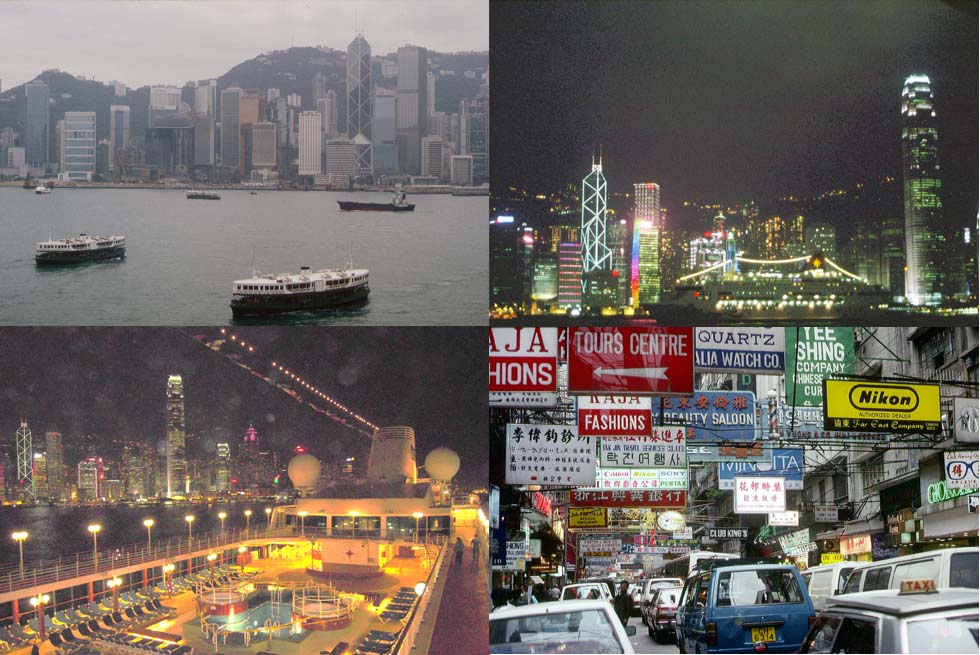
Hong Kong 2011
The new Hong Kong is represented by a wonderful sea promenade erected there and by the renovated subway system, extended into subterranean pedestrian malls. They are leading towards the Ocean Terminal and in this region also the building-site of the West Kowloon Terminus can be seen in that year 2011, the station of the high-speed railway to Guangzhou, which finally should connect Hong Kong with Beijing, 2,500km distant, in only 8 hours. On the other side, on Victoria Island, the new pedestrian zone is located on the first floor of the buildings, thus connecting the city quarter. It is Sunday when we are visiting it and we also find the St. Paul's Cathedral, where a Holy Mess is celebrated in Philippine language - and the church is filled with Filipinos, living there as migrant workers.
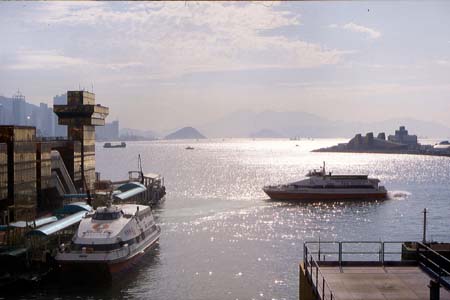
China Ferry Terminal, First Ferry quay 2011
|
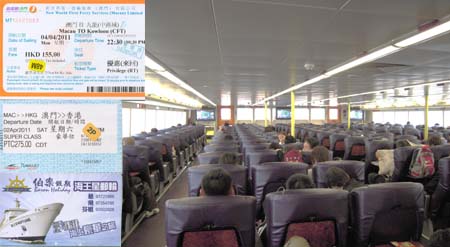
Austal catamaran, First Ferry of Macau
|
Situated close to the Ocean Terminal is the China Ferry Terminal, where hi-speed catamarans are coming and going. One of First Ferry is taking us on a trip to Macau - not before having passed the passport control, for Macau has an autonomy status like Hong Kong, too. The Austal catamaran is filled with bus seats, well occupied, and after departure the nearby skyscrapers of Kowloon are quickly left behind. The speed is rising, waves are splashing, freighters lay in the distance and other hi-speed catamarans of various companies are passing by. On one of the isles behind the green coast of Lantau Island there has been built the new Hong Kong International Airport and upstream the mouth of the Pearl River could be reached Guangzhou, the former Canton, the seaport older than Hong Kong. After a little more than an hour, high-rise buildings of Macau under a grey sky are coming into view and an immense road bridge, connecting Taipa Island, where the Macau International Airport has been erected offshore.
The catamaran arrives at Macau Maritime Ferry Terminal, hundreds of people have to wait for the passport control and the sign 'Centro de Controlo' reminds of Macau's Portuguese past, when its name was spelled Macao. For visiting the city, friends had advised not to take a taxi, but one of the many shuttle buses, waiting there for carrying the people to the casinos, free of charge. Their passengers surely need the money for gambling and already in the early afternoon the huge casinos are filled with thousands of gamblers - except us. A walk is sufficient for seeing the extravagance, the Rolls-Royce and Bentley de-luxe cars and even the still more rare Maybach. And the skyscrapers are sparkling in the background, being of an architecture varying from classic to "kitschy as kitsch can". For visiting the old Portuguese quarter on the hill there is not enough time, but we had seen it twenty years before and we had admired that little Portugal in Far East.
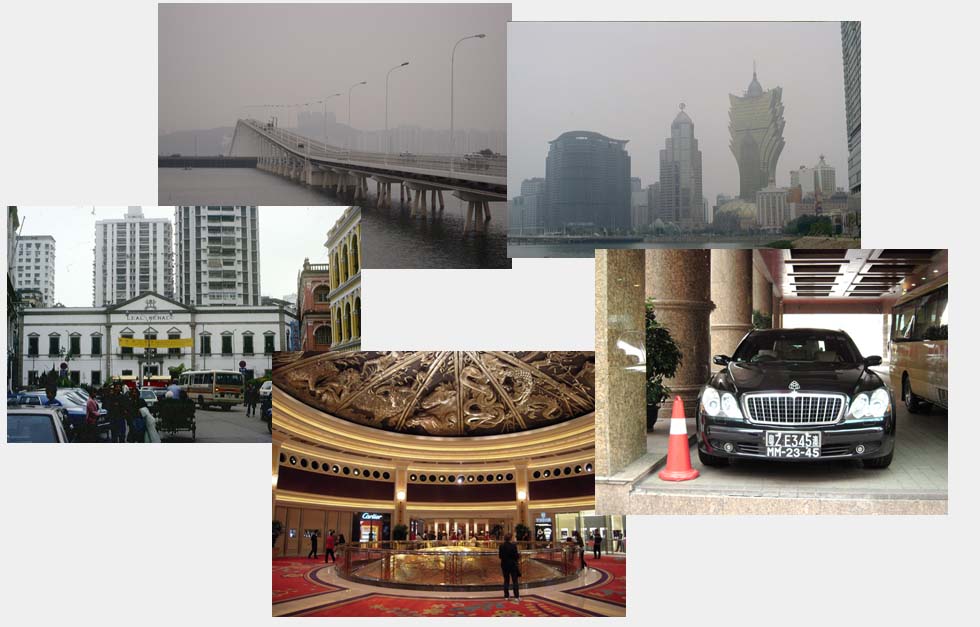
Macau
Back to Hong Kong, the hustle and bustle of this unique metropolis between Great Britain and China, between colonialism and globalization, is capturing the visitor. The crowded shopping malls, the traditional Peninsula Hotel, the Jaguars and Porsches, during evening hours the inns and bars and - always the highlight - the view of Victoria Island with its illuminated skyscrapers, the boats and casino ships passing by, that's simply overwhelming.
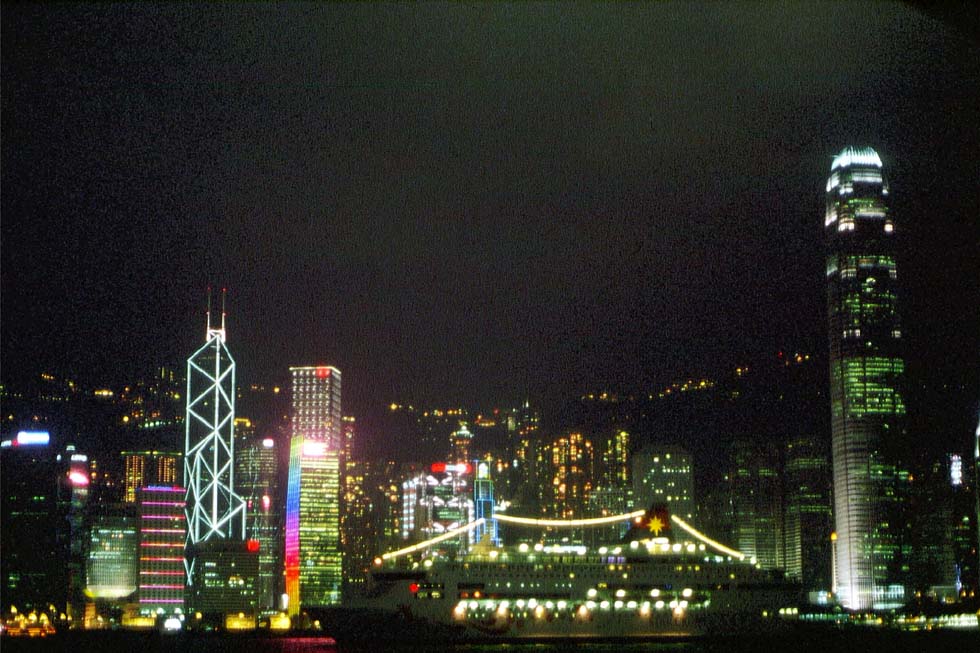
Hong Kong and the "Star Pisces", 2011
|